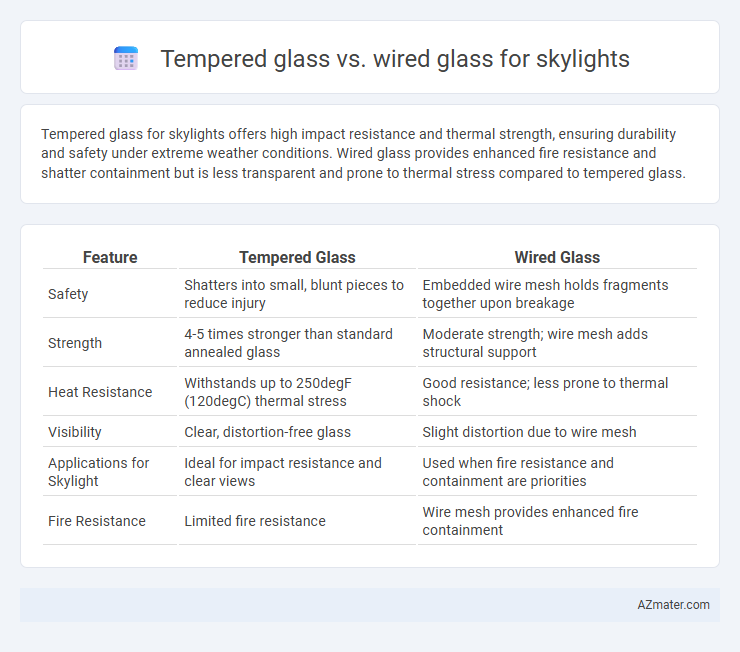Tempered glass for skylights offers high impact resistance and thermal strength, ensuring durability and safety under extreme weather conditions. Wired glass provides enhanced fire resistance and shatter containment but is less transparent and prone to thermal stress compared to tempered glass.
Table of Comparison
| Feature | Tempered Glass | Wired Glass |
|---|---|---|
| Safety | Shatters into small, blunt pieces to reduce injury | Embedded wire mesh holds fragments together upon breakage |
| Strength | 4-5 times stronger than standard annealed glass | Moderate strength; wire mesh adds structural support |
| Heat Resistance | Withstands up to 250degF (120degC) thermal stress | Good resistance; less prone to thermal shock |
| Visibility | Clear, distortion-free glass | Slight distortion due to wire mesh |
| Applications for Skylight | Ideal for impact resistance and clear views | Used when fire resistance and containment are priorities |
| Fire Resistance | Limited fire resistance | Wire mesh provides enhanced fire containment |
Introduction to Skylight Glazing Options
Tempered glass offers superior strength and safety for skylight glazing, resisting impact and thermal stress while providing clear, durable light transmission. Wired glass incorporates embedded wire mesh, enhancing fire resistance and preventing glass shattering, but it can slightly reduce transparency and aesthetic appeal. Choosing between tempered and wired glass for skylights depends on balancing safety requirements, visibility preferences, and building code compliance.
What is Tempered Glass?
Tempered glass is a type of safety glass processed by controlled thermal or chemical treatments to increase its strength compared to normal glass. It shatters into small, blunt pieces rather than sharp shards, reducing the risk of injury in skylight applications. Unlike wired glass, tempered glass offers superior clarity and impact resistance, making it a preferred choice for modern, energy-efficient skylights.
What is Wired Glass?
Wired glass is a safety glass that contains an embedded metal mesh, designed to hold the glass fragments together if shattered, providing fire resistance and impact safety for skylights. Tempered glass, by contrast, is heat-treated for increased strength and shatters into small, blunt pieces without a mesh. Wired glass is often preferred in applications requiring fire-rated skylights due to its superior fire containment properties.
Strength and Durability Comparison
Tempered glass offers significantly higher impact resistance and strength compared to wired glass, making it ideal for skylights exposed to harsh weather and potential physical impacts. While wired glass contains embedded wire mesh for fire resistance, its structural integrity is lower, and it is more prone to cracking under stress or impact. Tempered glass also undergoes heat treatment that enhances durability against thermal shocks, ensuring longer lifespan and improved safety in skylight applications.
Safety Features: Tempered vs Wired Glass
Tempered glass for skylights offers enhanced safety due to its ability to shatter into small, blunt pieces, reducing injury risk during breakage. Wired glass contains a metal mesh that holds shards together, preventing large fragments from falling but can pose hazards with sharp edges after impact. The choice between tempered and wired glass significantly impacts skylight safety, with tempered glass generally preferred for its superior breakage behavior and compliance with modern building codes.
Light Transmission and Aesthetics
Tempered glass skylights offer high light transmission, typically around 80-90%, providing clear, bright natural illumination that enhances aesthetics with a sleek, modern appearance. Wired glass generally transmits less light, approximately 70-75%, due to embedded wire mesh, resulting in a slightly diffused and less transparent look that can impact visual clarity. For skylight applications prioritizing maximum daylight and aesthetic appeal, tempered glass is preferred for its clarity and contemporary design, while wired glass emphasizes safety with a more industrial appearance.
Fire Resistance Considerations
Tempered glass for skylights offers moderate fire resistance with the ability to withstand sudden temperature changes up to 572degF (300degC), making it suitable for areas with limited fire exposure. Wired glass contains embedded wire mesh that provides enhanced fire resistance by maintaining structural integrity during high heat and preventing glass shards from falling, meeting fire-rated glazing standards often required in commercial buildings. Choosing between tempered and wired glass depends on local fire codes, the skylight's location, and the level of fire protection needed.
Installation and Maintenance Differences
Tempered glass skylights offer easier installation due to their uniform strength and less need for reinforced framing, while wired glass requires specialized framing to support its embedded mesh. Maintenance of tempered glass is simpler since it resists shattering and scratches, whereas wired glass may need more frequent inspections for wire corrosion and integrity. Both types require careful handling, but tempered glass generally reduces long-term upkeep costs and complexity compared to wired glass.
Cost Analysis: Tempered vs Wired Glass
Tempered glass for skylights typically costs more upfront than wired glass due to its enhanced strength and safety features, with prices averaging 20-30% higher per square foot. Wired glass offers a budget-friendly alternative, often priced 15-25% less but may incur additional expenses over time due to lower impact resistance and potential maintenance needs. Cost analysis should also consider installation complexity, lifecycle durability, and insurance implications linked to each glass type.
Choosing the Best Skylight Glazing for Your Needs
Tempered glass offers high impact resistance and safety for skylights, shattering into small, less harmful pieces upon breakage, making it suitable for areas prone to debris or weather stress. Wired glass provides enhanced fire resistance and better hold-in-place performance during breakage, ideal for meeting fire codes and increasing security in specific building applications. Selecting between tempered and wired glass depends on prioritizing either safety and impact durability or fire protection and code compliance for your skylight glazing needs.

Infographic: Tempered glass vs Wired glass for Skylight
 azmater.com
azmater.com